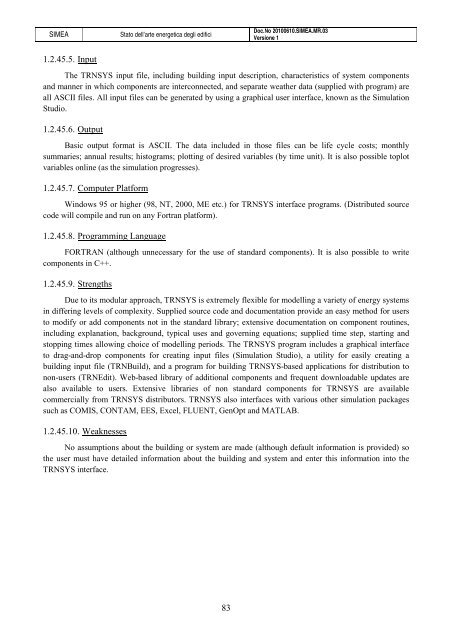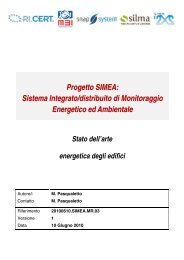Progetto SIMEA - Automatica - Università degli Studi di Padova
Progetto SIMEA - Automatica - Università degli Studi di Padova
Progetto SIMEA - Automatica - Università degli Studi di Padova
You also want an ePaper? Increase the reach of your titles
YUMPU automatically turns print PDFs into web optimized ePapers that Google loves.
<strong>SIMEA</strong> Stato dell’arte energetica <strong>degli</strong> e<strong>di</strong>fici<br />
1.2.45.5. Input<br />
83<br />
Doc.No 20100610.<strong>SIMEA</strong>.MR.03<br />
Versione 1<br />
The TRNSYS input file, inclu<strong>di</strong>ng buil<strong>di</strong>ng input description, characteristics of system components<br />
and manner in which components are interconnected, and separate weather data (supplied with program) are<br />
all ASCII files. All input files can be generated by using a graphical user interface, known as the Simulation<br />
<strong>Stu<strong>di</strong></strong>o.<br />
1.2.45.6. Output<br />
Basic output format is ASCII. The data included in those files can be life cycle costs; monthly<br />
summaries; annual results; histograms; plotting of desired variables (by time unit). It is also possible toplot<br />
variables online (as the simulation progresses).<br />
1.2.45.7. Computer Platform<br />
Windows 95 or higher (98, NT, 2000, ME etc.) for TRNSYS interface programs. (Distributed source<br />
code will compile and run on any Fortran platform).<br />
1.2.45.8. Programming Language<br />
FORTRAN (although unnecessary for the use of standard components). It is also possible to write<br />
components in C++.<br />
1.2.45.9. Strengths<br />
Due to its modular approach, TRNSYS is extremely flexible for modelling a variety of energy systems<br />
in <strong>di</strong>ffering levels of complexity. Supplied source code and documentation provide an easy method for users<br />
to mo<strong>di</strong>fy or add components not in the standard library; extensive documentation on component routines,<br />
inclu<strong>di</strong>ng explanation, background, typical uses and governing equations; supplied time step, starting and<br />
stopping times allowing choice of modelling periods. The TRNSYS program includes a graphical interface<br />
to drag-and-drop components for creating input files (Simulation <strong>Stu<strong>di</strong></strong>o), a utility for easily creating a<br />
buil<strong>di</strong>ng input file (TRNBuild), and a program for buil<strong>di</strong>ng TRNSYS-based applications for <strong>di</strong>stribution to<br />
non-users (TRNE<strong>di</strong>t). Web-based library of ad<strong>di</strong>tional components and frequent downloadable updates are<br />
also available to users. Extensive libraries of non standard components for TRNSYS are available<br />
commercially from TRNSYS <strong>di</strong>stributors. TRNSYS also interfaces with various other simulation packages<br />
such as COMIS, CONTAM, EES, Excel, FLUENT, GenOpt and MATLAB.<br />
1.2.45.10. Weaknesses<br />
No assumptions about the buil<strong>di</strong>ng or system are made (although default information is provided) so<br />
the user must have detailed information about the buil<strong>di</strong>ng and system and enter this information into the<br />
TRNSYS interface.
















